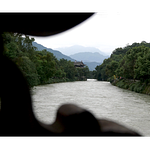“The Spring Festival Holiday is all about sitting in the house, chatting, cooking lots of food and eating with family,” says Mr周Zhōu, smiling contentedly as he steps into the traffic of Jiǔlǐdī East Street, crossing the busy road with the total fearlessness possessed only by Chinese elders. “Méiyou dǎsuàn!” I have no plans!
It’s a couple of days before Chinese New Year, and red lanterns are hanging from lampposts and trees, spreading luck and fortune and driving away年兽 Niánshòu, the mythical beast who comes out of hibernation each spring to prey on people and animals. With factories shut down as workers head back to their hometowns in droves, the smog-free sky welcomes the first day of brilliant sunshine. Wearing his usual blue and beige flannel shirt, our 78-year-old neighbour walks with surprising briskness along the pavement. “Come, I grow all my vegetables over there,” he says, pointing over the high, whitewashed brick wall to our left.
Having Mr Zhōu as our neighbour means that whenever we leave the apartment we risk returning with vegetables. The spontaneous gifts of gourds, loofahs, lettuces or water spinach may arrive in the lift, the courtyard or out on the street, but the interaction always retains the flavour of village life. When I finally ask if he can show me where the vegetables were coming from, he obliges without hesitation.
Near the street’s intersection, he turns off the pavement towards the wall and climbs over it via a makeshift breezeblock stile. Climbing after him and landing on the other side feels like being transported back several decades, to the village that stood here before the area, like much of China, was urbanised during the 1990s.
The grey, straight lines of the city street are replaced by a football pitch-sized expanse of green, bisected by well-trodden paths. Swathes of broad bean plants have opened their black and white flowers, which flutter in the breeze like butterflies. They are punctuated by every size, colour and shape of brassica, including numerous 红油菜hóngyóucài, or red canola, a bitter, purple vegetable I’ve been seeing a lot in local restaurants lately. The space feels like a farm, but its periphery of netted hardcore, broken glass and old furniture betrays the fact it’s actually a demolition site taken over by thirty opportunistic gardeners, of which Mr Zhōu is one.
A cat with fur thick with dirt darts across the path ahead of us, and my head snaps around instinctively to check our dogs’ whereabouts, before I remember that I decided to leave them at home: Mr Zhōu is a little nervous of our two harmless maniacs, and spaces like this are populated with extrememely territorial cats, their presence a guarantee of fireworks.
“My菜地càidì (vegetable plot) is right in the middle of the field,” says Mr Zhōu as he turns left, following a winding trail between vegetable patches. Frames, tunnels and other structures line the path, cobbled together from bamboo sticks and salvaged window frames. It’s hard to tell where one plot ends and another begins; as he guides me through the maze I’m reminded of the anarcho-order of a music festival campsite.
Growing spaces like this can be seen beside railway embankments, along overgrown stretches of canal or anywhere else there is荒地huāngdì (wasteland) across China. Their fluid boundaries are at odds with the regimented urban landscape, as Edwinn Schmitt observes in his PHD on environmental practices in Chengdu:
I find it striking that these individuals [are] able to work together within these abandoned construction plots […] based entirely on informal and completely unregulated agreements […] Moreover, these spaces do not require a government agency or even an NGO to facilitate such interaction (Schmitt, 2016).
Perhaps partly for this reason, ‘Intra-Urban Small-Scale Agriculture’ as it’s known is unacknowledged and even forbidden by local governments in China. Half-hidden in the long grass, an official sign reads: Cutting, planting and burning are all strictly prohibited. No random construction!
At last we reach Mr Zhōu’s plot, an oblong acre of which every inch of soil has been put to use. He proudly points out spinach, lettuce, spring onions, chives, coriander and – most abundantly –白菜báicài: the mild, elongated cabbage anyone who’s lived in East Asia will be familiar with. Thanks to Mr Zhōu our fridge is already packed with the things, but he hands me a plastic bag, pulls out a pocketknife and begins cutting báicài off at the root. I protest weakly as he drops one gigantic vegetable after another into the bag.
I ask Mr Zhōu if he ever sells his produce. “我不卖wǒbùmài!” he says definitively, waving his knife through the air as if nipping the idea in the bud. ‘I do not sell!’ It's all he really has to say on the matter, and according to a 2020 study by Geoff Luehr on Intra-Urban Small-Scale Agriculture in the city of Nánjīng, he is not alone in this:
A significant percentage of respondents (40.5 per cent) consumed more than 90 per cent of the food that they grew, with a further 33 per cent still consuming at least 70 per cent. Respondents would share unconsumed food with extended family, friends, neighbours first and, as a last resort, sold near their home or in another area of the city (Geoff Luehr, 2020).
The scent of a bonfire drifts over on the breeze, and despite the distant traffic it almost feels as if I’m no longer in a megacity, surrounded by high-rises. My mind turns to the immeasurable cost of China’s urbanization, which not only created one of the lowest endowments of farmland per capita in the world, but also an entire generation of newly urbanised farmers, their ties to the land severed:
This continues to impose an enormous burden on the agrarian population to devise an increasingly productive outcome year after year, just to maintain the stability of national food and nutritional levels (Natrajan, 2021).’
This situation is exacerbated by climate change, as Junjie Zhang, director of the environmental research center at Duke Kunshan University observed in China Daily:
Climate Change poses a ‘huge challenge to the sustainability of food production in China.’ Negative Impacts include: 'declining crop quality and yield, decreasing arable land quality, increasing price of water and fertilizers, aggravated crop pests and diseases, and more frequent and intense extreme climate events (Zhang, 2017).'
The CCP’s stance on these intersecting crises is to meet them with unprecedented investments. Chéngdū is the site of ambitious urban greening projects, seeking to rebalance the quality of life for urban residents by planting tens of thousands of trees and constructing the world’s longest pedestrianised greenway. And to meet food production goals, the government is investing heavily in high-tech, industrial urban agriculture; vertical, hydroponic and aquaponic farms as well as ‘plant factories (Natrajan, 2021).’
Seeing the satisfaction on Mr Zhōu’s face as he hands me a huge bundle of spinach, I can’t help feeling the answers are often simpler than we think. He and his fellow gardeners are improving biodiversity, restoring nitrogen to the soil, recycling household waste through composting as well as providing a low-carbon food source, just meters from their homes.
In the days following our visit to Mr Zhōu’s allotment, our interactions have taken on an added warmth. Bumping into him as he takes his baby grandson for an afternoon stroll, he holds both my hands in his, inviting me and Tamzin to see in the new year with his family.
Sitting on the L-shaped sofa in his apartment watching a State TV channel's official new year countdown, we thank Mr Zhōu as he refills our cups with chrysanthemum tea. His grandson wriggles contentedly in my lap, scratching at the stubble on my chin with tiny fingernails. Mr Zhōu’s wife, daughter and son-in-law are preparing a feast in the kitchen.
We’ve spent several Spring Festivals in China, but rarely have we felt this connected to our local area. I’m reminded of another line in Geoff Leurh’s study, which discusses a much-overlooked social benefit of urban gardening:
‘Growing food allow(s) individuals to build social networks, which (is) especially important for those who recently moved into urban areas (Geoff Luehr, 2020).’
Like us, Mr Zhōu has only lived in Chéngdū for a few years. He’s originally a native of西昌Xīchāng, a city 350 kilometers south of here. As he slowly falls asleep on the sofa beside us, I reflect that without his farming practice, we would probably have spent Chinese New Year alone, doing our own thing, surrounded by families celebrating just meters away .
As the climate crisis intensifies and food systems around the world come under threat, strong communities will be paramount in overcoming scarcity of resources and space. Spending time on Mr Zhōu’s vegetable plot showed us one way we can build connections with the land, with our food and with each other.
Thanks for reading! If you enjoyed this post, head over to our YouTube channel and check out this video, in which we explore the topic of urban agriculture further and Mr Zhou plays a starring role!

















Share this post